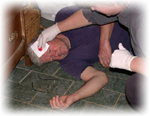Research
| Harrington Software Associates (creator of the Long-Term Care Learning Center) was founded in 1997. We specialize in developing innovative, research-based training solutions for long-term care facility owners, operators and staff. Our training courses were developed through funding by the National Institute on Aging, National Institute of Nursing Research, and the National Institute for Occupational Safety and Health. |
(Click the links below to view abstracts of our research projects.)
Research Projects:
- Preparing Long-Term Care Facilities for Natural and Man-Made Disasters
- Restorative Care Training for Staff in Long Term Care Facilities
- Web-Based Fire Safety Training for Board and Care Staff
- Using CBT and the Web to Train Board and Care Staff
- Ergonomics for Nursing Facilities
- Using CD-ROM Technology to Train Long-Term Care Staff
Research Projects:
| Preparing Long-Term Care Facilities for Natural and Man-Made Disasters National Institute of Aging Grant Number: 2R44AG029692 Project Dates: 8/01/2008 – 7/31/2011 |
 |
Despite state and federal requirements for emergency planning, there is growing evidence that suggests long-term care facilities are ill-prepared for a disaster. The purpose of the proposed research is to reduce the risk of disaster-related deaths and injuries to older adults in long-term care. This goal will be accomplished through the development and evaluation of a comprehensive emergency preparedness curriculum. The computer-based training materials developed from this curriculum will provide long-term care owners, administrators, and facility emergency planning teams with the knowledge, skills, and tools they need to develop, implement, and practice an emergency operations plan.
During Phase I, researchers convened a multidisciplinary advisory group of experts to discuss the challenges long-term care facilities face when developing and implementing an emergency plan and responding to an actual disaster event. The advisory group developed a detailed emergency preparedness curriculum. Researchers evaluated the curriculum in a pilot test with 43 owners, operators, and facility disaster coordinators from assisted living facilities and skilled nursing facilities. Posttest results suggest that the curriculum as presented improved the participants’ knowledge, attitudes, and intended practices related to emergency preparedness. The average improvement from pre to posttest was 31.71%, which was significant at the .0005 level. Participant evaluation of each module on six criteria (clarity, usefulness, importance, interest, comprehensiveness, and length) suggests a strong approval of the curriculum.
During Phase II, the curriculum will be the basis for the development of an interactive, computer-based training program. Modules will combine text, graphics, animation, sound, and high-resolution video to create a fully-interactive media-rich, learner-controlled environment. The program will be evaluated in a national field test with small, medium, and large long-term care facilities, using a randomized pretest/posttest experimental design with a control group. The field test will also include an evaluation of participants’ emergency operations plans prior to the training and one month after the training.
The training program resulting from this research project will be available from the Long-Term Care Learning Center in 2010. [top]
| Restorative Care Training for Staff in Long Term Care Facilities National Institute of Aging Grant Number: 2R44AG028194 Project Dates: 5/01/2008 – 4/30/2011 |
 |
The long-range goal of this proposed research is to improve the quality of life of older people who live in assisted living facilities by training staff in restorative care techniques. This goal will be achieved by developing and validating a comprehensive multimedia restorative care training program. Each module will use a three-part approach: interactive computer-based training (for providing knowledge and improving attitudes), video-based instruction (for demonstrating techniques), and print materials (to instruct participants on how to practice skills with another staff member through role play.) Module topics will include: restorative care philosophy/benefits and specific ADLs, e.g. dressing, dining, ambulation, toileting, exercising, grooming, bathing, and cognitive and social skills. Researchers will also develop a module for facility owners, administrators, and family members on the benefits of implementing a facility-wide restorative care program.
During Phase I, researchers successfully developed and pilot tested a prototype module on dressing. During Phase II, researchers will complete the development of the remaining restorative care modules, conduct a pilot test of those modules, prepare the program for delivery in three formats (Web based, CD-ROM, and Interactive DVD), and conduct a field test of the complete program.
This training program will help long term care administrators and staff develop positive attitudes toward restorative care. It will also help staff understand their role in creating independent residents, resulting in improved quality of care and improved quality of life for older adults.
The training program resulting from this research project will be available from the Long-Term Care Learning Center in 2010. [top]
| Web-Based Fire Safety Training for Board and Care Staff National Institute of Aging Grant Number: 2R44AG026193 Project Dates: 5/01/2005 – 03/31/2009 |
 |
Web technology is currently underutilized despite the great promise that it offers and the enormous need for training that exists. Web-based training can reduce many of the existing barriers for delivering training, allowing providers to complete the program at their own facilities to receive continuing education credits from their state licensing agencies.
A comprehensive, interactive web-based fire safety training program will give caregivers the knowledge and skills they need to prevent a fire and to respond correctly in a fire emergency. The program will include interaction, animation, video, graphics and narration to create a media-rich learning environment.
The Phase I pilot study demonstrated the effectiveness of a prototype web-based training module on the topic of fire emergency planning. Study participants who completed the training significantly improved their scores from pre- to posttest when compared to a control group. Participants indicated on the course evaluation that the computers were easy to use for training (97%) and that they would like to use computers for future training courses (97%). Phase II will expand the research to include the development of two new web-based training modules on the topics of identifying and eliminating fire hazards and installing, testing, and maintaining fire safety devices. Researchers will evaluate the program in a national field test.
The training program resulting from this research project will be available from the Long-Term Care Learning Center in 2009. [top]
| Using CBT and the Web to Train Board and Care Staff National Institute of Aging Grant Number: 2R44AG018678 Project Dates: 9/30/2001 – 3/31/2006 |
 |
This study investigated the effects of 10 injury prevention computer-based training modules tested by 120 participants from 65 facilities that provide care or support to elderly people needing long-term care. The training was delivered either on CD-ROM or at a Web site. A repeated measures analysis was performed with module scores on a pretest and 10 posttest. The main effect of time was significant, demonstrating that participants scored higher at posttest. The main effect of module was also significant, suggesting that participants performed at significantly different levels on various modules. Evaluation results found that participants were strongly positive about the training content and delivery 15 method. After the initial training, a 3-month follow-up study was conducted with 4 of the modules with 71 (59.2%) of the original participants. Gains continued to be significant for the 4 tested modules as compared to control groups.
The training program resulting from this research project is available from the Long-Term Care Learning Center in the on-line courses catalog. [top]
| Ergonomics for Nursing Facilities National Institute of Nursing Research Grant Number: 1R43NR07919 Project Dates: 9/01/2002 – 8/31/2003 |
 |
The proposed project will support the National Institute of Nursing Research’s mission “to prevent or delay the onset of disease or disability or slow its progression, to find effective approaches to achieving and sustaining good health, and to improve the clinical settings in which care is provided.” Considering the nursing facility industry’s high injury rate, this research is critically important to staff, residents, and management.
Phase I demonstrated the need for an ergonomics intervention for managers. HSA pilot-tested “Ergonomics for Nursing Facility Managers” with administrators and managers (N = 45) from twenty-five long-term care facilities. At pretest, less than 34% of the participants indicated that they had received ergonomics training in the past and less than 20% had read OSHA’s Ergonomics Guidelines for Nursing Facilities. A majority at pretest did not know specific details such as whether a cart with larger or smaller wheels was easier to push, the definition of ergonomics, the injury rate at their facility, or OSHA’s policy on ergonomics. Of the 25 participating facilities, 15 reported that they did not have an ergonomics program in place at their facility.
Results from Phase I also demonstrated the potential for interactive training to improve ergonomic knowledge, attitudes and intended practices of nursing facility managers. The Treatment Group significantly increased overall scores between pre- and posttest. Differences between the pre- and posttest mean scores were significant for the total score (t = 8.37, df = 21, p = .0005) for the Knowledge subtest (t = 7.00, df = 21, p = .0005) and for the Practices subtest (t = 7.28, df = 21, p = .0005). Participants improved their mean score on the Attitudes subtest, but the difference was not significant. Differences between mean scores for the Control Group were not significant for the total score or for any subtest. In a follow-up, researchers found that after a three-month interval participants performed significantly better on the follow-up than they had on the pretest. However, losses from posttest to follow-up were also significant demonstrating the need for periodic training.
At pretest, 47% of participants indicated that they had evaluated their staff’s tasks to prevent musculoskeletal disorders, 24% indicated that they stayed current on changes in ergonomic technology and 60% indicated that they designed their staff’s tasks to make work more comfortable. At posttest, 100% of participants indicated that they planned to evaluate their staff’s tasks to prevent musculoskeletal disorders and to make work more comfortable. All participants indicated that they planned to stay current on changes in ergonomics technology. In addition, all participants indicated they would recommend the program to others, computers were easy to use for training, and they would like to use computers for future training topics. Ninety-six percent responded that the training program was useful to them as managers.
The training program resulting from this research project is available from the Long-Term Care Learning Center in the CD-ROM catalog. [top]
| Using CD-ROM Technology to Train Long-Term Care Staff National Institute of Nursing Research Grant Number: 2R44NR04743 Project Dates: 9/01/1999 – 8/31/2002 |
 |
During Phase II, researchers designed and developed four computer-based training modules and conducted a pilot and national field test with over 1,600 nursing facility staff. In the pilot test, 289 staff from a large North Carolina nursing facility were randomly assigned to a computer-based (CB) (n = 152) or instructor-led (IL) group (n = 137). Both the CB and IL groups significantly improved their scores from pre- to posttest on the subtests (knowledge, attitudes, and practices) of each module. Results of the pilot test study were used to revise the materials for the national field test.
In the field test, the CB and IL versions of the fire safety training program were presented to staff of nine nursing facilities. Participants (N = 1,294) were randomly assigned to the CB (n = 670) or IL (n = 624) groups. Both groups significantly increased their knowledge, attitude, and practice scores from pre- to posttest. Participants reported that they enjoyed the CB training and had no difficulty using the computers.
Researchers found that computer-based training was more effective than instructor-led training at increasing participants' knowledge. The findings from the national field test demonstrated that the computer-based (CB) group (n = 670) significantly outperformed the instructor-led (IL) group (n = 624) on the knowledge subtest at posttest (F (1) = 6.138, p = .013). Differences between groups for the attitudes and practices subtests were not significant.
The training program resulting from this research project is available from the Long-Term Care Learning Center in the CD-ROM catalog. [top]
